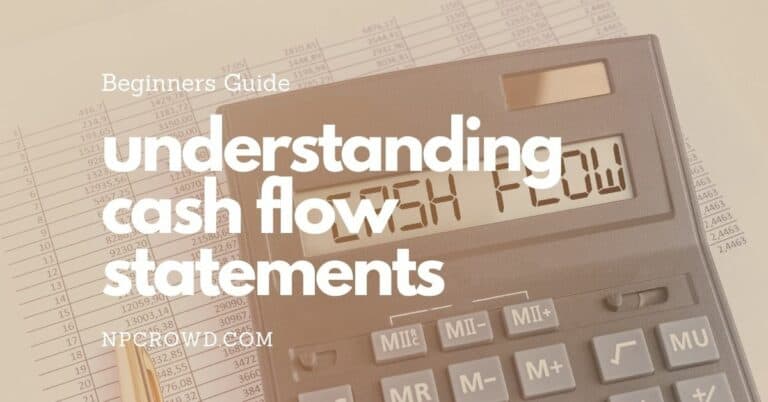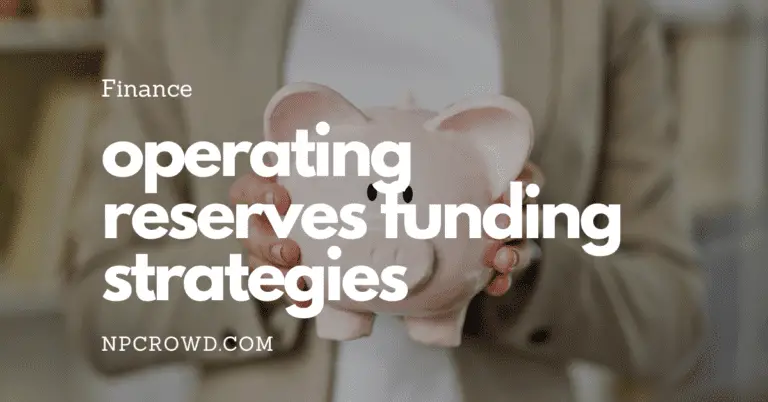Nonprofit Financial Management 101: Your Starter Guide
Disclaimer: This post may contain affiliate links. These links, if used and purchases made, we may earn a small commission. These affiliate programs do not impact the recommendations we make or the resources we refer you to. Our focus is on providing you the best resources for your nonprofit journey.
As a nonprofit executive, it is your responsibility to ensure that the organization is financially stable and sustainable. This can be a daunting task, especially if you are new to the world of nonprofit financial management.
But don’t worry! This guide will walk you through the basics of nonprofit financial management so that you can make informed decisions about your organization’s future.
Roles In Nonprofit Financial Management
There are a few key roles in financial management for our sector. The Board of Directors, the Executive Director, and the Finance Committee. While other specific roles may exist, these three are most commonly found in early startup stage organizations.
Board of Directors: The Board is responsible for setting the strategic direction of the organization and ensuring that it is fiscally responsible.
Executive Director: The Executive Director is responsible for the day-to-day operations of the organization and ensuring that it meets its financial obligations. The Executive Director may also be called the CEO or President.
Finance Committee: The Finance Committee is responsible for overseeing the financial health of the organization and making recommendations to the Board of Directors on financial matters.
Now, this doesn’t mean you don’t need a bookkeeper or accountant. It also doesn’t mean that as your charitable organization grows you won’t have a finance manager or even a CFO in large nonprofits. The roles above are a starting point.
Reading Financial Statements
In order to understand financial statements, you must first understand what an organization’s financial statements are trying to communicate.
Financial statements are organized around an organization’s overall mission, and they provide information about an organization’s ability to generate revenue and revenue growth, as well as its ability to control expenses.
Below is a quick summary of the four most common financial statements: Statement of Activities, Statement of Financial Position, Statement of Functional Expenses, and Statement of Cash Flows.
Statement of Activities (Profit & Loss Statement)
The Statement of Activities is a financial statement that provides information about an organization’s revenue and expenses. It is also sometimes referred to as the Statement of Operations or in business, a Profit & Loss Statement or “P&L”.
A nonprofit Statement of Activities (Income Statement) is a financial statement that provides information about an organization’s revenue and expenses over a period of time. The statement can be used to assess an organization’s financial performance and to identify trends.
Revenue is the money an organization receives from its activities. Expenses are the costs incurred by an organization to generate revenue.
The Statement of Activities can be used to assess an organization’s ability to generate revenue and control expenses.
LEARN MORE: Take 10 minutes and read our article Understanding The Statement of Activities: A Beginner’s Guide. You’ll learn the fundamental components of the Statement of Activities.
What is a nonprofit Statement of Financial Position (Balance Sheet)
A nonprofit Statement of Financial Position (Balance Sheet) is a snapshot of an organization’s financial health at a particular point in time. The statement provides information about an organization’s assets, liabilities, and net assets.
Assets are everything an organization owns, and they can be either current assets or long-term assets. Current assets are cash and other assets that can be converted to cash within one year. Long-term assets are assets that will take longer than one year to convert to cash.
Liabilities are everything an organization owes, and they can be either current liabilities or long-term liabilities. Current liabilities are obligations that are due within one year. Long-term liabilities are obligations that are due after one year.
Net assets are the difference between an organization’s assets and liabilities. Net assets can be either unrestricted, which means they can be used for any purpose or restricted, which means they can only be used for specific purposes.
The Statement of Financial Position can be used to assess an organization’s financial health, as well as its ability to generate revenue and control expenses.
What is a Statement of Functional Expenses
A nonprofit Statement of Functional Expenses is a financial statement that provides information about an organization’s expenses by function. The statement can be used to assess an organization’s investments in its programs versus other functional areas of the organization.
Functional expenses are the costs incurred by an organization to generate revenue classified by the functional area of the nonprofit for which those expenses were generated.
The Statement of Functional Expenses can be used to assess the percentage of expenses spent on programmatic areas versus administrative, fundraising, and other areas.
This percentage is often used by organizations and donors to make funding decisions.
What is a Statement of Cash Flows
The statement of cash flows is a financial statement that provides a snapshot of a nonprofit organization’s inflows and outflows of cash, which is the money coming in and going out of the organization. It can be used to track the organization’s financial health and spot trends over time.
The Statement of Cash Flow is usually broken down by month or quarter. and typically provides information going back at least one year.
For nonprofits that have excessive expenses in one part of the year, like a summer camp, the statement of cash flows can demonstrate the building up of revenues prior to the start of the season and whether they are sufficient to cover anticipated expenses based on historical performance.
LEARN MORE: Learn the basics of reading a Cash Flow Statement in less than 10 minutes in our article: Understanding Nonprofit Cash Flow Statements: A Beginners Guide
Liquidity
The ability to pay expected and unexpected bills important in the life of a nonprofit. When we talk about that ability to pay, we often use a term called Liquidity.
Liquidity in a nonprofit is referring to the Liquid Unrestricted Net Assets (LUNA). This is money the nonprofit has in its possession that is unrestricted and clear of liabilities that can be used for paying expenses, both expected and unexpected.
While there are two methods of determining liquidity health, MOCH, and LUNA.
MOCH: Months Of Cash on Hand – This method is prone to overstating the liquidity within an organization as it may include restricted assets in the calculation.
LUNA: Liquid Unrestricted Net Assets – This method provides a true picture of liquidity given it only takes into account unrestricted net assets while also ensuring that long-term debts are covered.
We recommend the LUNA method as it provides the most realistic assessment of a nonprofit’s true liquidity.
Full Cost of Nonprofit Operations
Program expenses alone are not the true cost of operating a nonprofit. A nonprofit’s full cost is represented by the following items.
- Program Expenses
- Operating Costs
- Liquidity
- Fixed Assets
- Growth Capital
- Reserves
- Debt
Whether for budgeting, expense tracking, planning, or reporting purposes, a potentially successful nonprofit deals in full costs to paint the full picture.
Budgeting for Nonprofits
Organizing and managing finances is a critical part of any nonprofit organization, yet it can be a daunting task for those who are not familiar with the ins and outs of financial management.
As a nonprofit organization, your budget is a tool that allows you to track your income and expenses, and to make informed decisions about how to allocate your resources. A well-managed budget can help you to achieve your organization’s goals, and to maintain financial stability.
Just like a for-profit business, you won’t know for certain how much in donations (contribution income) your organization can raise. And you can’t predict with 100% accuracy what your program expenses will be.
However, you can use budgeting to give yourself a road map for where you want your organization to go, and to track your progress along the way.
There are two main types of budgets that nonprofits use:
Operating budgets: An operating budget is a year-long plan that includes both your income and expenses. This type of budget is used to track the day-to-day operations of your organization.
Capital budgets: A capital budget is a long-term plan that includes major expenses, such as building renovations or the purchase of new equipment. This type of budget is used to track large, one-time expenses.
Focus on the Operating budget as every organization needs this and is usually what is being discussed when talking about budgets.
When creating a budget, you will need to consider both your fixed costs and your variable costs.
Fixed costs are those expenses that remain the same from month to month, such as rent or salaries. Variable costs fluctuate and can include things like supplies or travel expenses.
You will also need to consider your income, which can come from a variety of sources, such as donations, grants, and investment as well as fee or service income known as program income.
LEARN MORE: The foundations of nonprofit budgeting are available to you today in our article: Basics of Nonprofit Budgeting: A Beginners Guide. In less than 15 minutes you will know how to start.
Types of Budgeting (Historical vs. Zero Based)
There are two primary types of budgeting: historical and zero-based.
Historical budgeting starts with the previous year’s budget and simply adjusts it for inflation and any other known changes. This type of budgeting is common in government and other organizations where there is little change from year to year.
Zero-based budgeting, on the other hand, starts from scratch each year. Every expense must be justified and every income source must be accounted for. This type of budgeting is more common in businesses, where change is more frequent.
Most nonprofits use the historical budgeting method because their expenses and income sources tend to be fairly stable from year to year. However, there may be times when a nonprofit needs to use a zero-based budget, such as when there is a significant change in the organization’s programs or when the organization is experiencing financial difficulties.
Creating a budget
There are a number of ways to create a budget. You can use a spreadsheet program, such as Microsoft Excel, or you can use budgeting software, such as Quicken or QuickBooks.
You may also want to hire a professional accountant to help you create your budget.
Once you have created your budget, be sure to review it regularly and make changes as needed. Your budget should be a living document that evolves as your organization grows and changes.
Considerations for your 1st year’s nonprofit budget
One-time startup costs
When you’re first starting out, there are certain one-time costs that you will need to account for in your budget. These may include the cost of incorporation, the cost of renting office space, or the cost of purchasing equipment.
Recurring costs
There are also certain costs that you will need to account for on a monthly or yearly basis. These may include the cost of salaries, the cost of insurance, or the cost of rent.
Income
Your budget will also need to account for your income. This can come from various sources, such as donations, grants, investment income, or fee-for-service income.
LEARN MORE: Donations and grants are not the only income sources for a nonprofit. Make sure you know all your options by reading Nonprofit income sources you should know.
When creating your budget, it is important to be realistic about your income. Keep in mind that you may not receive income from all of your sources every month and that your income may fluctuate from month to month.
FAQ
Do nonprofits have financial statements? While nonprofits are not required to have financial statements, it is recommended by the National Council of Nonprofits. Financial statements can provide valuable information about a nonprofit’s financial health and performance. However, they are required for some grants, audits, and certifications.







